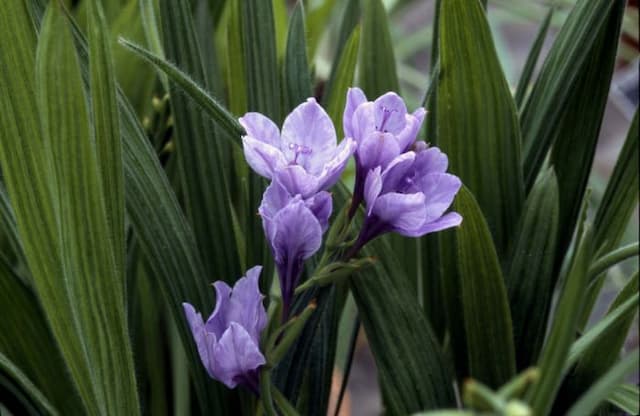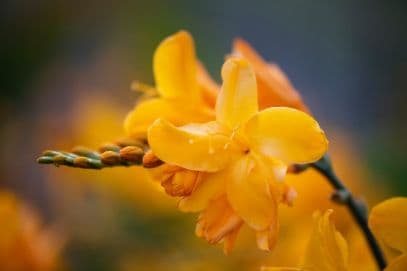Intermediate Bearded Iris Iris 'Katie-koo' (IB)

ABOUT
Iris 'Katie-koo' is a captivating variety of bearded iris marked by its striking blooms. This plant showcases flowers with a unique combination of colors; the petals can exhibit a blend of shades, commonly featuring tones that might range from soft pastels to more intense hues. The flowers of the 'Katie-koo' are characterized by their classic iris shape, having three upright petals often referred to as "standards" and three downward-curving petals called "falls." The falls may display ruffling or be adorned with beard-like hairs at their centers, which can be a contrasting color to the rest of the petal. The foliage of this bearded iris consists of long, sword-shaped leaves that typically grow in a fan-like formation. These leaves are a rich, vibrant green and create an attractive backdrop for the showy flowers that make the 'Katie-koo' a garden favorite. The overall look of this iris cultivar is one of elegance and charm, making it a standout plant in any garden setting where it provides a stunning display of floral beauty.
About this plant
 Names
NamesFamily
Iridaceae
Synonyms
Katie-koo Iris, Intermediate Bearded Iris
Common names
Iris 'Katie-koo' (IB)
 Toxicity
ToxicityTo humans
The Iris 'Katie-koo', commonly known as the bearded iris, is not considered highly toxic to humans. However, it can cause mild symptoms if ingested, as irises contain compounds such as irisin, iridin, or irisine, which can provoke gastrointestinal discomfort. If parts of the plant are consumed, possible symptoms can include nausea, vomiting, abdominal pain, and diarrhea. Contact with the plant's sap may also cause skin irritation or an allergic reaction in sensitive individuals.
To pets
For pets, the bearded iris can be mildly to moderately toxic. If ingested, pets, especially dogs and cats, may exhibit signs of gastrointestinal upset including vomiting, drooling, diarrhea, and abdominal pain. In some instances, consuming large amounts of the plant's rhizomes could potentially cause more serious issues such as lethargy or an overall weakness. If you suspect your pet has consumed parts of the bearded iris, it's advisable to contact a veterinarian.
 Characteristics
CharacteristicsLife cycle
Perennials
Foliage type
Deciduous
Color of leaves
Green
Flower color
Mixed
Height
2 feet (60 cm)
Spread
2 feet (60 cm)
Plant type
Bulb
Hardiness zones
3
Native area
Temperate Northern Hemisphere
Benefits
 General Benefits
General Benefits- Visual Appeal: The Iris 'Katie-koo' offers striking flowers that can add vibrant color and visual interest to gardens and landscapes.
- Drought Tolerance: This plant is relatively drought-tolerant once established, making it suitable for xeriscaping and low-water gardens.
- Ease of Care: It is considered low-maintenance, requiring minimal care once it is settled in an appropriate environment.
- Cold Hardy: Iris 'Katie-koo' has the ability to withstand colder temperatures, it is suitable for planting in a variety of climates.
- Pollinator Attraction: The flowers attract bees, butterflies, and other pollinators, supporting local ecosystems.
- Versatility in Landscaping: It can be used in a range of landscape designs, including borders, containers, and as cut flowers.
- Seasonal Interest: Provides seasonal interest with its blooms typically in late spring to early summer.
- Propagation: It can easily be propagated through division, allowing gardeners to expand their collection or share with others.
 Medical Properties
Medical PropertiesThis plant is not used for medical purposes.
 Air-purifying Qualities
Air-purifying QualitiesThis plant is not specifically known for air purifying qualities.
 Other Uses
Other Uses- Artistic inspiration: Artists often use the striking blooms of the Iris 'Katie-koo' as a subject for paintings, drawings, and other forms of art.
- Photography: The flowers' vibrant colors and intricate patterns make them a popular choice for photographers looking to capture the beauty of nature.
- Culinary decoration: While not a traditional edible flower, petals can be used for ornamental purposes to decorate desserts and salads, provided they are free of pesticides and other chemicals.
- Eco-friendly dye: The petals of the Iris 'Katie-koo' can be used to make a natural dye for fabrics, though it may not be as colorfast as synthetic dyes.
- Companion planting: Irises can be planted among other garden plants to create diverse habitats that attract beneficial insects and improve plant health.
- Symbolism and gifts: Due to their captivating appearance, they are often given as gifts to represent hope, wisdom, and compliments.
- Water garden aesthetic: Irises are commonly used to enhance the aesthetic of water gardens or ponds, contributing to a natural and serene environment.
- Fragrance extraction: Although not a common use, Iris 'Katie-koo's subtle fragrance can be extracted for use in homemade potpourri or natural perfumery.
- Soil erosion control: The plant's root system can help stabilize soil and prevent erosion in sloped gardens or along riverbanks.
- Festivals and events: Iris 'Katie-koo' flowers can be used in floral arrangements at events and festivals, especially those celebrating spring and nature.
Interesting Facts
 Feng Shui
Feng ShuiThe Iris is not used in Feng Shui practice.
 Zodiac Sign Compitability
Zodiac Sign CompitabilityThe Iris is not used in astrology practice.
 Plant Symbolism
Plant Symbolism- Faith: The Iris is often associated with faith, belief, and hope, making it a symbol of trust and expectation.
- Wisdom: Historically, the Iris represented wisdom and valued knowledge, both in the spiritual and intellectual sense.
- Courage: In some cultural contexts, the striking appearance of the Iris is a symbol of courage and admiration.
- Royalty: The flower's connection to monarchies and its regal presence have made it a representation of royalty and majesty.
- Purity: Due to its delicate shape and clean lines, the Iris can symbolize purity and innocence.
- Messages: The Iris is often considered a bearer of good news and messages, reflecting its role in Greek mythology where Iris was a messenger goddess.
- Honor: The flower is also associated with honor and respect, making it a suitable representation for recognizing someone's achievements or character.
- Hope: The Iris conveys a message of hope, conveying optimism for the future.
 Water
WaterIntermediate bearded irises like 'Katie-koo' should be watered deeply once a week during their active growth period, especially if there hasn't been significant rainfall. Ensure that the soil is well-drained to avoid waterlogging, as irises do not like standing in water. During the summer dormancy, reduce watering to prevent rot, adjusting for particularly hot or dry spells where additional water may be needed. Provide about one inch of water each time, which is approximately 0.6 gallons for a square foot of soil, ensuring even distribution to reach the roots effectively.
 Light
LightIntermediate bearded irises such as 'Katie-koo' thrive best in full sun conditions, meaning they should receive at least six hours of direct sunlight daily. A location that provides morning sun and some afternoon shade can be beneficial, especially in hotter climates to prevent foliage burn. Do not plant them in heavy shade as this will impede their growth and reduce flowering.
 Temperature
TemperatureIntermediate bearded irises, including 'Katie-koo', perform well in a range of temperatures, but they prefer climates where the temperature ranges between 75°F and 90°F during the growing season. They are cold hardy and can survive winter temperatures as low as -30°F. Ideally, aim to maintain a temperature around 70°F for optimal growth and flowering.
 Pruning
PruningPrune intermediate bearded irises like ‘Katie-koo’ to remove spent flower stalks immediately after blooming to encourage healthy growth and division. Cut back the foliage to about 4-6 inches above the ground in the late fall to tidy up the plant and reduce the risk of harboring disease over winter. Divide the clumps every 3-5 years in late summer to maintain vitality and prevent overcrowding.
 Cleaning
CleaningAs needed
 Soil
SoilThe best soil mix for an Intermediate Bearded Iris like 'Katie-koo' should be well-draining and moderately fertile. A blend of loamy garden soil, compost, and coarse sand or perlite works well. This Iris prefers a soil pH slightly acidic to neutral, ranging from 6.5 to 7.0.
 Repotting
RepottingIntermediate Bearded Irises like 'Katie-koo' don't typically require frequent repotting and do well when left undisturbed. However, they should be divided and repotted every 3 to 5 years to maintain vigor and flower production.
 Humidity & Misting
Humidity & MistingIntermediate Bearded Irises such as 'Katie-koo' are tolerant of a range of humidity levels and do not require high humidity. Average ambient humidity is generally adequate for healthy growth.
 Suitable locations
Suitable locationsIndoor
Ensure bright light, minimal watering, cool temperatures.
Outdoor
Plant in partial to full sun, well-draining soil.
Hardiness zone
3-9 USDA
 Life cycle
Life cycleIris 'Katie-koo', commonly known as Intermediate Bearded Iris, begins its life cycle as a dormant rhizome, which starts to grow roots and shoots typically in late winter or early spring. It enters into a growth stage developing long, sword-shaped leaves and strong stems, preparing to support blossoms. The flowering period occurs in late spring to early summer, where the iris showcases its colorful blooms ranging from purples, blues, to whites and yellows. After pollination, often by bees, the blooms fade and seed pods may form, containing the potential for new plants. Throughout the summer, foliage continues photosynthesis to store energy in the rhizome for the following season. As temperatures drop in fall, the iris enters dormancy, with leaves dying back, and the cycle is poised to recommence the next spring.
 Propogation
PropogationPropogation time
Late summer to fall
Propogation: Iris 'Katie-koo', also known as an Intermediate Bearded Iris, is typically propagated through division of the rhizomes, ideally performed after flowering has ceased and the plant has entered a period of dormancy, which is often late summer to early fall. To propagate by division, the clumps of rhizomes should be carefully dug up and the excess soil removed gently. Using a sharp knife, the rhizomes can be cut apart, ensuring each division has at least one fan of leaves and a portion of the roots. The leaves should be trimmed to about one-third of their height to reduce moisture loss. After cutting, it is beneficial to allow the divisions to dry for several hours to a day to help the cut areas callus, which reduces the risk of rot when planted. The divided rhizomes can then be replanted in well-draining soil, positioned so that the top of the rhizome is just above the soil surface. They should be spaced 12 to 24 inches apart (30 to 60 cm) to allow for good air circulation and room for growth.









